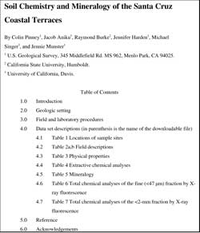Marine terraces in the central coast of California provide an opportunity to study a soil chronosequence in which similar materials (beach deposits) have been weathered under similar slope, climatic, and vegetation conditions during the Quaternary. The terraces between Santa Cruz and Año Nuevo, California, have been studied for decades and are thought to be one of the best example of marine terraces in California {Lawson (1893), Wilson (1907); Branner and others (1909), Rode (1930) Page and Holmes (1945), Alexander (1953), Bradley (1956, 1957, 1958, and 1965), Bradley and Addicott (1968), Clark (1966 and 1970), Jahns and Hamilton (1971), Lajoie and others (1972), Bradley and Griggs (1976). Hanks and others (1986), Aniku (1986), Fine and others (1988), Anderson (1990 and 1994), and Rosenbloom and Anderson (1994).} Here we report morphological, chemical, physical, and mineralogical data for the soils that were formed in deposits on the Santa Cruz marine terraces in order to examine soil characteristics as a function of increasing terrace age.


